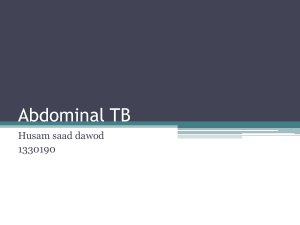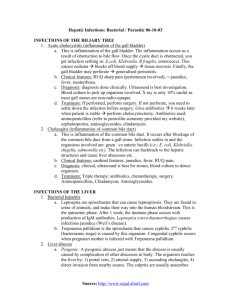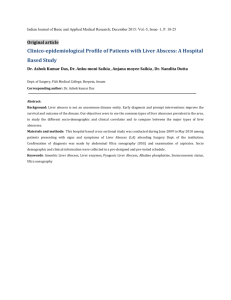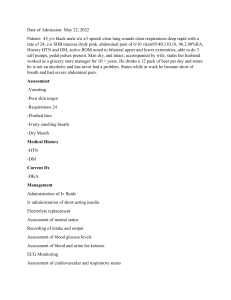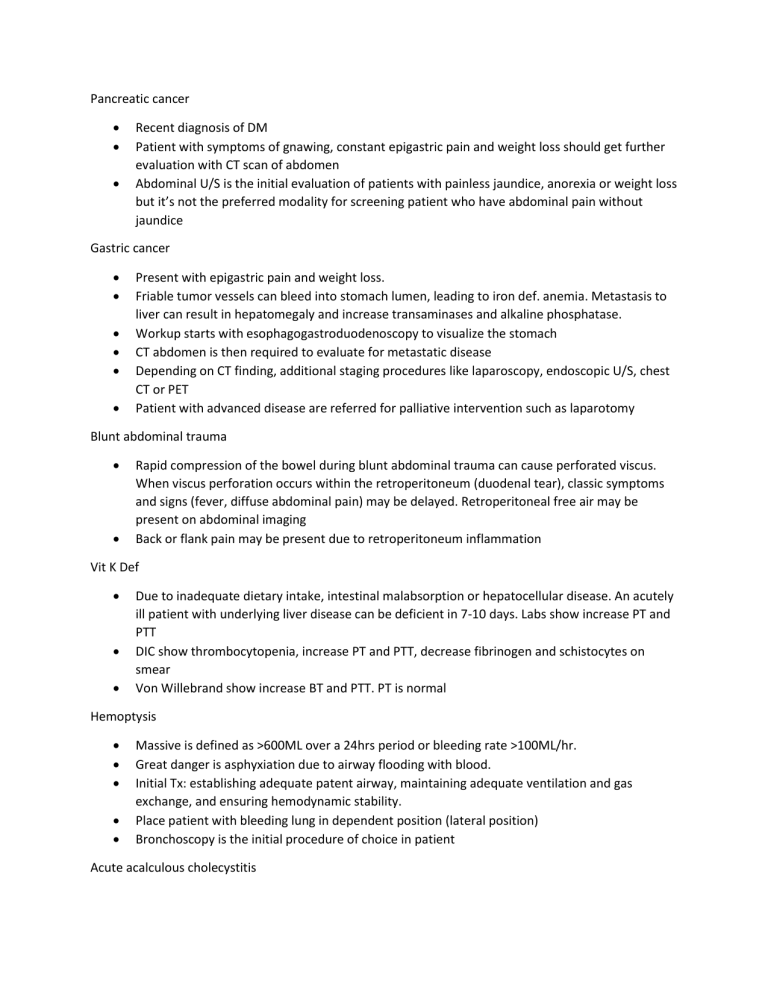
Pancreatic cancer Recent diagnosis of DM Patient with symptoms of gnawing, constant epigastric pain and weight loss should get further evaluation with CT scan of abdomen Abdominal U/S is the initial evaluation of patients with painless jaundice, anorexia or weight loss but it’s not the preferred modality for screening patient who have abdominal pain without jaundice Gastric cancer Present with epigastric pain and weight loss. Friable tumor vessels can bleed into stomach lumen, leading to iron def. anemia. Metastasis to liver can result in hepatomegaly and increase transaminases and alkaline phosphatase. Workup starts with esophagogastroduodenoscopy to visualize the stomach CT abdomen is then required to evaluate for metastatic disease Depending on CT finding, additional staging procedures like laparoscopy, endoscopic U/S, chest CT or PET Patient with advanced disease are referred for palliative intervention such as laparotomy Blunt abdominal trauma Rapid compression of the bowel during blunt abdominal trauma can cause perforated viscus. When viscus perforation occurs within the retroperitoneum (duodenal tear), classic symptoms and signs (fever, diffuse abdominal pain) may be delayed. Retroperitoneal free air may be present on abdominal imaging Back or flank pain may be present due to retroperitoneum inflammation Vit K Def Due to inadequate dietary intake, intestinal malabsorption or hepatocellular disease. An acutely ill patient with underlying liver disease can be deficient in 7-10 days. Labs show increase PT and PTT DIC show thrombocytopenia, increase PT and PTT, decrease fibrinogen and schistocytes on smear Von Willebrand show increase BT and PTT. PT is normal Hemoptysis Massive is defined as >600ML over a 24hrs period or bleeding rate >100ML/hr. Great danger is asphyxiation due to airway flooding with blood. Initial Tx: establishing adequate patent airway, maintaining adequate ventilation and gas exchange, and ensuring hemodynamic stability. Place patient with bleeding lung in dependent position (lateral position) Bronchoscopy is the initial procedure of choice in patient Acute acalculous cholecystitis Acute inflammation of gallbladder in absence of gallstones. Seen in hospitalized patients who are critically ill Present with unexplained fever and diffuse or RUQ pain. You see jaundice, RUQ mass, leukocytosis or abnormal LFT Dx: U/S; if unclear do abdominal CT or cholescintigraphy (hepatobiliary iminodiacetic acid) scan Empyema Bacterial pneumonia commonly causes a pleural effusion. Often the effusion is small, sterile and resolves with antibiotics (uncomplicated). However, if bacteria persistently cross into the pleural space, a complicated parapneumonic effusion or empyema can develop. Empyemas have frank pus or bacteria (by gram stain) in the pleural space and require drainage (chest tube) in addition to prolonged antibiotics Sialadenosis Benign noninflammatory swelling of salivary glands. It result from overaccumulation of secretory granules in acinar cells in patients with chronic alcohol use, bulimia or malnutrition Can also result from fatty infiltration of glands in patients with diabetes mellitus or liver disease Cirrhosis Patient with cirrhosis are unware until they develop complications such as hepatocellular carcinoma that present with decompensated liver failure (ascites, jaundice, hypoalbuminemia), weight loss and palpable liver lesion. AFP is usually elevated. Triple phase arterial contrast CT scan of abdomen is diagnostic Conductive hearing loss Caused by disorder of external auditory canal (cerumen impaction, otitis externa), tympanic membrane (perforation), middle ear space (otitis media, cholesteatoma), or ossicular chain (otosclerosis) Otosclerosis results from an imbalance of bone resorption and deposition that leads to stiffening and ultimately fixation of stapes. May progress during pregnancy and it is autosomal dominant. Tx is hearing amplification or surgical reconstruction of stapes Sensorineural hearing loss= meniere disease, aminoglycoside antibiotics, presbycusis, and vestibular schwannoma Intra-abdominal abscess Patients who receive a laparoscopic appendectomy are at much greater risk for intra-abdominal abscess than those receiving laparotomy. Intra-abdominal abscess should be suspected when fever, pain, vomiting return days after an abdominal operation Boerhaave syndrome Esophageal perforation Forceful retching increase intraesophageal pressure to cause full thickness effort rupture of esophagus leading to efflux of esophageal fluid and air in mediastrinum. The leaked GI content cause chest/abd pain, fever. The leaked air (pneumomediastinum) may be palpated as suprasternal crepitus (subcutaneous emphysema Dx: esophagography or CT scan with water soluble contrast Tx: IV antibitics and PPI, oral intake restricted and emergent surgical consultation Mallory Weiss: mucosal tear; submucosal venous or arterial plexus bleeding giving you hematemesis. Dx by upper GI endoscopy and most heal spontaneously Spinal cord injury Central cord syndrome is common after whiplash type injuries in older adults with underlying cervical spondylosis. Damage to the central cervical spinal cord causes upper extremity motor, sensory, and reflex abnormalities; sacral (bowel/bladder) and lower extremity function is generally preserved Post-amputation pain Acute stump pain o Tissue and nerve injury o Severe pain lasting 1-3 weeks Ischemic pain o Swelling, skin discoloration o Wound breakdown o Decrease transcutaneous oxygen tension Post traumatic neuroma o Weeks to months after amputation o Focal tenderness, altered local sensation o Decrease pain with anesthetic injection Phantom limb pain o Onset within 1 week o Increased risk in patients with severe acute pain o Intermittent cramping, burning felt in distal limb Pancreatic injury Persistent abdominal discomfort/tenderness Persistent nausea/emesis Increasing amylase over serial measurement Peripancreatic fluid collection (due to pancreatic duct injury) Cardiac tamponade Cardiac catheterization reveals elevated and equilibrated intracardiac diastolic pressures (right atrial, right ventricular, and PCWP suggestive of left atrial pressure) Urgent echocardiography should be performed for definitive diagnosis and management Warfarin Patient on warfarin who require urgent surgery with high risk of bleeding or those experiencing hemorrhage should get prothrombin complex concentrate and IV vitamin K. if unavailable Give fresh frozen plasma Liver abscess Entamoeba histolytica is a protozoan that cause colitis or extraintestinal (liver, pleura, brain) illness in patients who live in or travel to developing countries. Amebic liver abscess has RUQ pain, fever and a single subcapsular lesion in right lobe. Dx is made with serology Renal artery stenosis Severe hypertension and recurrent flash pulm. Edema in setting of diffuse atherosclerosis suggests Renal artery stenosis. Associated finding are CKD and evidence of secondary hyperaldosteronism (hypokalemia, increase bicarbonate); urinalysis is bland and Dx is confirmed with renal imaging (renal U/S with doppler) Salter harris Fracture Aka juvenile tilaux fracture is characterized by fracture of distal tibial epiphysis and lateral physis (growth plate) and occurs in adolescent when the physis is fused. Injury to growth plate can cause growth arrest and lead to persistent limb length discrepancy. Other complication are formation of physeal bars (bony bridges across the growth plate) premature osteoarthritis and decrease range of motion Scaphoid fracture Displaced scaphoid fracture should be considered for surgical intervention. Wrist immobilization with a cast can be considered for nondisplaced fracture but patients should be monitored with serial X-ray to rule out osteonecrosis of proximal segment and nonunion of the fracture Basal cell carcinoma Appear as an enlarging fleshy nodule with ulceration. Associated with sun exposure and is most common on face, neck and extremities Osteomyelitis Diabetic foot infections are deep, long standing are polymicrobial with a mixture of grampositive (S. aureus, S. Pyogenes), gram-negative (Pesodomonas) and anaerobic organisms. Underlying osteomyelitis is common due to contiguous spread from the wound Urethral stricture Characterized by fibrotic narrowing of urethra and occurs in bulbar portion Are idiopathic and secondary causes include urethral trauma (pelvic fracture, iatrogenic instrumentation), infection (sexually transmitted urethritis) and radiotherapy Can lead to urine retention, recurrent UTI, bladder stones Patient have obstructive type voiding symptoms (weak urine stream, urinary spraying) Dx: elevated postvoid residual volume….voiding cystourethrogram or cystourethroscopy can confirm the diagnosis Tx: urethral dilation or surgical urethroplasty

